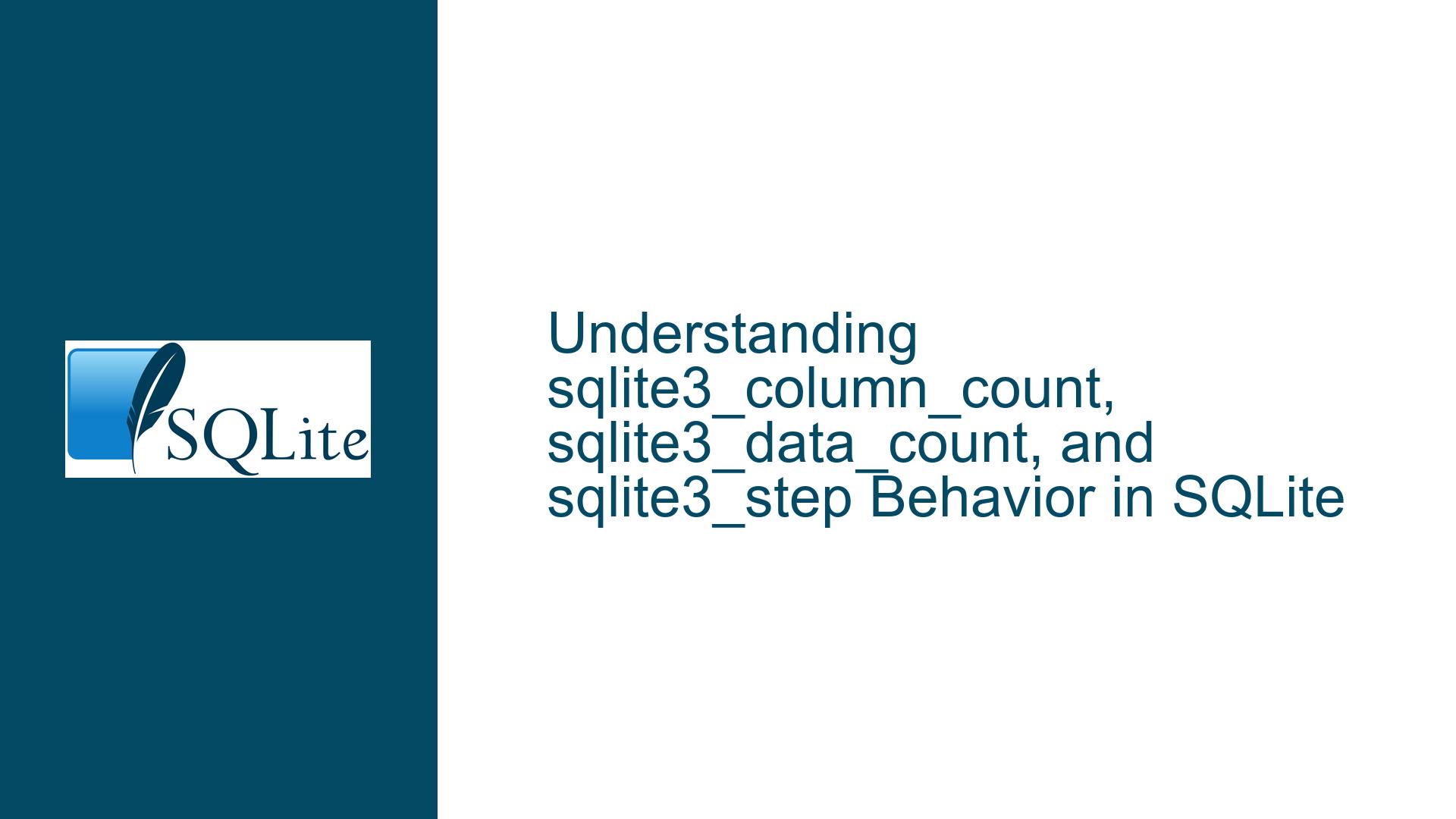sqlite3_column_count, sqlite3_data_count, and sqlite3_step Behavior in SQLite
Issue Overview: Clarifying sqlite3_column_count, sqlite3_data_count, and sqlite3_step Interactions
The core issue revolves around understanding the behavior of three critical SQLite C API functions: sqlite3_column_count, sqlite3_data_count, and sqlite3_step. Specifically, the confusion arises from how these functions interact when executing SQL statements, particularly in scenarios where no rows are returned or when the structure of the result set is in question. The primary questions are:
- Does
sqlite3_stepalways returnSQLITE_DONEwhensqlite3_column_countis positive but no rows are returned? - Can the number of columns in a result set vary by row within a single prepared statement?
These questions touch on the fundamental mechanics of SQLite’s execution model, particularly how it handles result sets and communicates their structure and content to the caller. Misunderstandings in this area can lead to incorrect assumptions in application logic, such as assuming that a result set’s structure can change dynamically or that the absence of rows implies a specific return code from sqlite3_step.
Possible Causes: Misinterpretation of API Documentation and Result Set Mechanics
The confusion stems from a combination of factors, including ambiguous interpretations of the SQLite documentation and a lack of clarity on how SQLite internally manages result sets. Let’s break down the potential causes:
Misreading the Documentation: The documentation for
sqlite3_column_countstates that aSELECTstatement will always have a positivesqlite3_column_count, but it does not explicitly clarify the behavior ofsqlite3_stepwhen no rows are returned. This omission can lead to uncertainty about whethersqlite3_stepwill returnSQLITE_DONEorSQLITE_ROWin such cases.Confusion Between
sqlite3_column_countandsqlite3_data_count: The distinction between these two functions is subtle but critical.sqlite3_column_countreturns the number of columns in the result set of a prepared statement, whilesqlite3_data_countreturns the number of columns in the current row of the result set. Misunderstanding this distinction can lead to incorrect assumptions about whether the number of columns can vary by row.Assumptions About Result Set Variability: The idea that the number of columns in a result set could vary by row is a common misconception, especially for developers coming from databases that support dynamic schemas or sparse data structures. SQLite, however, enforces a fixed schema for result sets, meaning the number of columns is determined at prepare time and cannot change during execution.
Overlooking the Role of
sqlite3_step: The behavior ofsqlite3_stepis central to understanding how SQLite processes result sets. Developers may not fully grasp thatsqlite3_stepis responsible for advancing through the result set and that its return codes (SQLITE_ROWandSQLITE_DONE) are the primary indicators of whether data is available for processing.
Troubleshooting Steps, Solutions & Fixes: Clarifying SQLite’s Result Set Handling
To resolve the confusion and ensure correct usage of sqlite3_column_count, sqlite3_data_count, and sqlite3_step, follow these detailed steps:
1. Understanding sqlite3_step Return Codes
The behavior of sqlite3_step is well-defined and consistent. When executing a prepared statement, sqlite3_step will return one of the following codes:
SQLITE_ROW: Indicates that a new row of data is available for processing. This is returned for each row in the result set of aSELECTstatement or any other statement that generates rows (e.g.,RETURNINGclauses inUPDATEorINSERTstatements).SQLITE_DONE: Indicates that the statement has finished executing successfully and no more rows are available. This is returned after all rows have been processed or for statements that do not return rows (e.g.,UPDATE,DELETE, orINSERTwithoutRETURNING).
Key Takeaway: If a SELECT statement has a positive sqlite3_column_count but no rows match the query criteria, sqlite3_step will return SQLITE_DONE immediately, as there are no rows to process. This behavior is consistent regardless of the presence or absence of rows.
2. Clarifying sqlite3_column_count and sqlite3_data_count
The distinction between these two functions is crucial for understanding how SQLite manages result sets:
sqlite3_column_count: This function returns the number of columns in the result set of a prepared statement. The count is determined at prepare time and remains constant throughout the execution of the statement. For example, aSELECTstatement that retrieves three columns will always have asqlite3_column_countof 3, even if no rows are returned.sqlite3_data_count: This function returns the number of columns in the current row of the result set. It is only meaningful after a call tosqlite3_stepthat returnsSQLITE_ROW. Ifsqlite3_stephas not yet been called or if it returnsSQLITE_DONE,sqlite3_data_countwill return 0.
Key Takeaway: The number of columns in a result set is fixed and determined by the SQL statement at prepare time. sqlite3_data_count reflects the availability of data in the current row, but it does not imply any variability in the result set’s structure.
3. Addressing the Variability of Columns by Row
A common misconception is that the number of columns in a result set can vary by row. This is not the case in SQLite. The result set’s structure is determined at prepare time and remains consistent throughout execution. Each row in the result set will have the same number of columns, even if some columns contain NULL values.
For example, consider the following SQL statement:
SELECT name, age FROM users WHERE age > 30;
The result set will always have two columns (name and age), regardless of how many rows match the condition. If no rows match, sqlite3_step will return SQLITE_DONE, and sqlite3_data_count will return 0, but sqlite3_column_count will still return 2.
Key Takeaway: The number of columns in a result set is fixed and cannot vary by row. Any perceived variability is likely due to confusion between sqlite3_column_count and sqlite3_data_count.
4. Practical Examples and Debugging Tips
To solidify your understanding, consider the following practical examples and debugging tips:
- Example 1: No Rows Returned
sqlite3_stmt *stmt;
const char *sql = "SELECT name, age FROM users WHERE age > 100;";
sqlite3_prepare_v2(db, sql, -1, &stmt, NULL);
int column_count = sqlite3_column_count(stmt); // Will be 2
int step_result = sqlite3_step(stmt); // Will be SQLITE_DONE
int data_count = sqlite3_data_count(stmt); // Will be 0
In this example, sqlite3_column_count returns 2 because the SELECT statement specifies two columns. However, since no rows match the condition (age > 100), sqlite3_step returns SQLITE_DONE, and sqlite3_data_count returns 0.
- Example 2: Rows Returned
sqlite3_stmt *stmt;
const char *sql = "SELECT name, age FROM users WHERE age > 30;";
sqlite3_prepare_v2(db, sql, -1, &stmt, NULL);
int column_count = sqlite3_column_count(stmt); // Will be 2
int step_result = sqlite3_step(stmt); // Will be SQLITE_ROW if rows exist
int data_count = sqlite3_data_count(stmt); // Will be 2 if step_result is SQLITE_ROW
In this example, sqlite3_column_count returns 2, and if rows match the condition, sqlite3_step returns SQLITE_ROW, and sqlite3_data_count returns 2.
- Debugging Tip: Check
sqlite3_stepBefore Usingsqlite3_data_count
Always check the return value of sqlite3_step before calling sqlite3_data_count. If sqlite3_step returns SQLITE_DONE, sqlite3_data_count will return 0, and attempting to access column data will result in undefined behavior.
5. Best Practices for Handling Result Sets
To avoid common pitfalls and ensure robust code, follow these best practices:
- Always Check
sqlite3_stepReturn Codes: Use the return value ofsqlite3_stepto determine whether data is available. Do not assume that a positivesqlite3_column_countimplies the presence of rows. - Use
sqlite3_column_countfor Result Set Structure: Rely onsqlite3_column_countto determine the structure of the result set. This count is fixed and will not change during execution. - Use
sqlite3_data_countfor Row-Specific Data: Usesqlite3_data_countto determine whether data is available in the current row. This function is only meaningful after aSQLITE_ROWreturn fromsqlite3_step. - Avoid Assumptions About Column Variability: Remember that the number of columns in a result set is fixed and cannot vary by row. If you encounter unexpected behavior, double-check your SQL statement and the logic used to process the result set.
By following these steps and best practices, you can confidently use sqlite3_column_count, sqlite3_data_count, and sqlite3_step in your SQLite applications, ensuring accurate and efficient handling of result sets.






